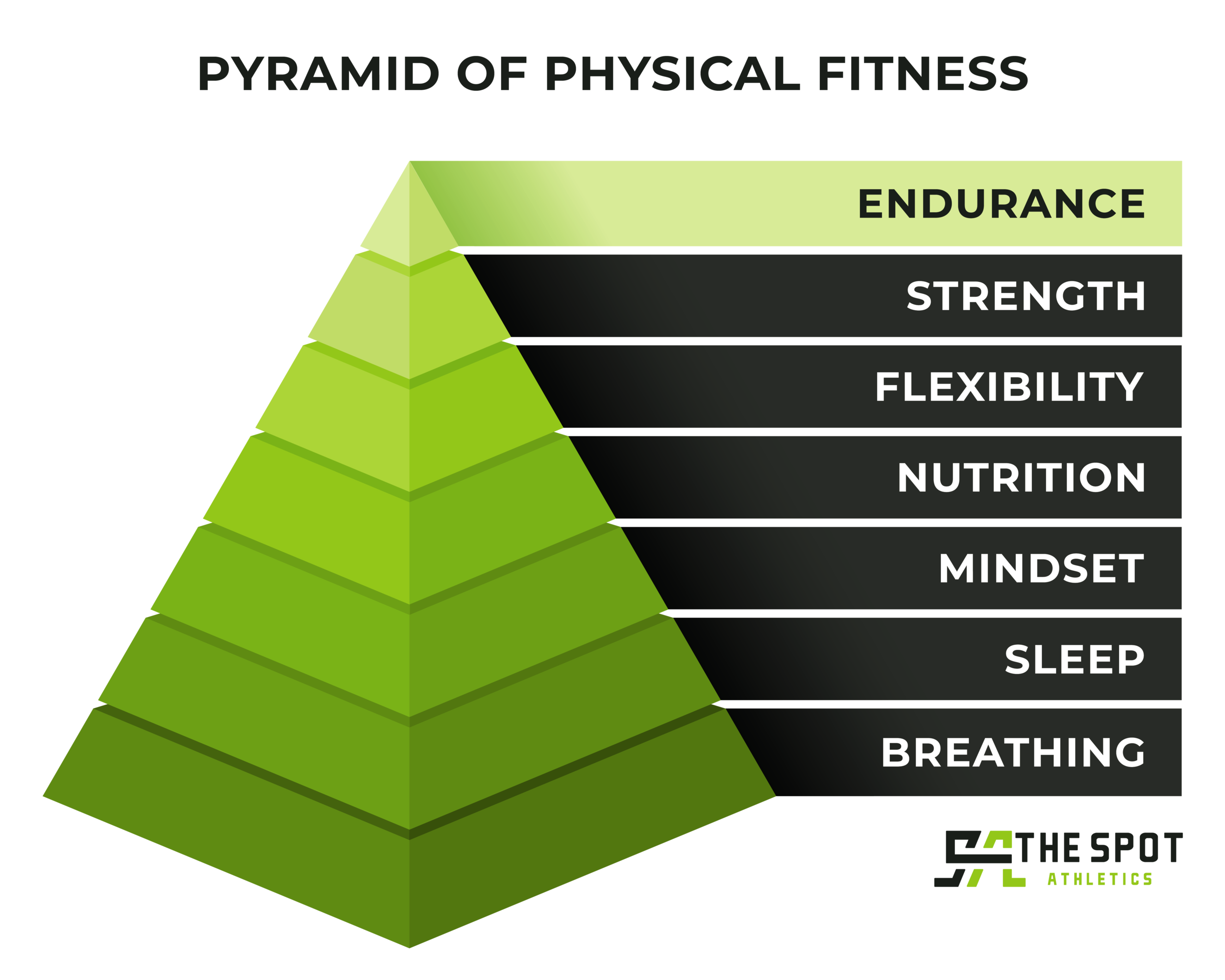Many people think of endurance as the place where physical fitness should start. They decide to get in shape and they head right to the nearest cardio equipment or buy a new pair of running shoes. However, endurance should be taken care of last, not first, in prioritizing fitness. The fact that people traditionally place endurance first is why we have a society that is overweight and riddled with injuries. As you can see from the Pyramid of Physical fitness, endurance is the very top of the pyramid, the “cherry on top” if you will.
Endurance is at the top of the pyramid because you must have the required flexibility and strength to complete an activity. You can’t have endurance in an activity that you can not physically do. You also have to remember that what you can do now, will change over time. If someone only does endurance work and doesn’t keep up their flexibility and strength, pretty soon they will lack all three. People go straight to the endurance part because it’s what they know and it’s the simplest to do. However, do not mistake simple for easy, as the endurance portion of training is often mishandled resulting in injuries or exercise burn out.
What is Endurance Training?
To fully understand endurance training, you must understand the different means in which it can be accomplished. Some people believe endurance work is super long sessions on a piece of cardio equipment or really long runs. While this can be part of a complete endurance program, it is definitely not where most people should start or what their entire program should consist of. Many people believe all endurance work must be super hard and leave you in a pile of sweat. While that is sometimes true, taking this approach to endurance training in every session will lead to quitting or an injury. Good endurance work manages changes in volume, intensity, and load over time. This ensures the person can recover from workouts and get better month after month.
To understand how this is done, you must understand the different energy systems in the body and how they are trained.
Here are the four systems:
Oxidative - (Aerobic)
Glycolytic Alactic - (Anaerobic)
Glycolytic Lactic - (Anaerobic)
Phosphagen - (Anaerobic)
Two quick points before we get into how to train each of these systems. The first point is that Aerobic simply means “with oxygen”, Anaerobic means “without oxygen”. The second point is something that has become a big pet peeve of ours over the years. You have probably heard the term “lactic acid” in regard to muscle soreness or fatigue, however, both of those common remarks are inaccurate. Lactic acid does not exist inside the human body, lactate does. And lactate does not cause muscle soreness.
How is it done?
Oxidative System:
To train this system you must 1. keep your heart rate between 120-155 & 2. do an activity for longer than two minutes straight. This system requires oxygen to create fuel for the body to move. This system is the most important as it is the powerplant for recovery when the other systems are being used.
Glycolytic Alactic System:
To train this system you must 1. Elevate the heart rate over 155 & 2. Do an activity for 10-20 seconds. This system also requires longer rest periods in between bouts. If you do not let the heart rate return down around 120 before the next bout, then you are no longer training the Alactic system.
Glycolytic Lactic:
To train this system you must 1. Elevate the heart rate over 155 & 2 do an activity for 20-120 seconds. This is the most overused form of endurance training in fitness as it is the hardest. Many people equate hard with good, which is a mistake. Many trainers only give people this form of endurance work as it ensures people will think their training in “hard”. Well, any idiot can make someone tired. Here at the Spot Athletics, we don’t care about merely making you tired, we want to make you better.
Phosphagen System:
To train this system you must 1. Give maximum effort in an activity & 2. Do an activity for 0-10 seconds. This system is most commonly used in very short, intense sprints and weightlifting for up to 3 reps. When training this system, the person must rest long enough to be able to give another maximum effort.
What’s that look like?
When most people think of endurance, they think of running. Endurance work does NOT need to be jogging or sprints. It can literally be any activity that you want. It could be swimming or going up the stairs, it does not matter. All that matters is that you get yourself in the proper heart rate and/or intensity for the proper amount of time.
Looking at the four different systems, you could understand how a good endurance program may include a fast walk for 30m that gets the heart rate to 125. It may also include a hard 15s of activity followed by 90s of rest. Yes, I said rest. Simply pushing as hard as you can the whole time only trains the Glycolytic lactic system. This develops an incomplete endurance profile, limits fitness, and may cause a host of other issues. The bottom line is, if you are looking for long-term, sustainable results, you need to train all four systems. Your goals will dictate how much and when. The important part is that you understand where endurance work fits in and what the different systems are, so you can properly put the cherry on top of your physical fitness.


